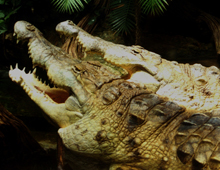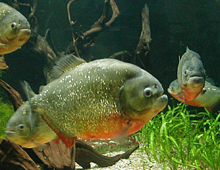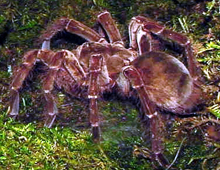Crocodile Cove

Orinoco crocodile, Crocodylus intermedius
This large species is similar to the American crocodile. The body is made up of scales (scutes) that vary in shape and strength. Orinoco crocodiles can be identified by the arrangement of dorsal (back) armor with six prominent scales on the back of the neck. Osteoderms (bony deposits within each scale) are rough in texture and are often different in color. Orinoco crocodiles have no osteoderms on their light colored belly, Another identifying feature of the Orinoco crocodile is the narrow snout which slopes upward near the tip. The nostrils are set at the end to allow breathing while mostly submerged. The tongue is wide and attached to the bottom of the mouth and does not aid in the capturing of prey. Their body color varies from gray-green, tan, to gray scattered with dark green. The legs are short and strong; the long tail is quite powerful.
LEARN MORE
Aquatic caecilian, Typhlonectes natans
Very few of the 180 or so caecilian species are easily exhibited in zoos or aquariums, as most live underground. This South American species is an exception, living in water instead. It has been bred in captivity, including the DWA, giving birth to live young. Confined to parts of the Old and Near World Tropics, caecilians compose one of the three orders of amphibians (the other two being frogs and toads, and salamanders). They are the only living amphibians with scales, but these are hidden beneath their skin.
LEARN MORE
Mata mata turtle, Chelus fimbriatus
A resemblance to a pile of rotting leaves serves this reptile well. When unaware small fishes swim too close, they disappear instantly — sucked in by a powerful vacuum created when it opens its jaws. Found in quiet water across a large area of tropical South America, it usually only comes onto land to lay its eggs. It rarely swims, preferring to walk underwater, taking air at the surface through the unique proboscis in front of its tiny eyes.
LEARN MORE
Red-bellied piranha, Pygocentrus nattereri
It appears there are no documented cases of piranhas killing people, but there have been several cases where they have eaten humans that had drowned. In general, these specialized relatives of the tetras are opportunistic scavengers. Of the 50 or so species found in South American Rivers, this one is the most familiar, and is popular in aquariums for its bright colors. If maintained in groups of less than four, piranhas are likely to eventually kill each other. They have been bred many times in captivity.
LEARN MORE
Goliath bird-eating spider, Theraphosa blondi
Until 2001, when the Giant huntsman spider was discovered in Laos, this enormous tarantula of the Northern South American rainforests was known as the largest spider in the world, and is still the heaviest. The legs may span one foot and they can weigh up to six ounces. While it is certainly capable of eating small birds, their more usual prey is insects, frogs, and lizards. Their venom is comparable to that of a wasp, but they are also capable of damaging human skin with their detachable irritating hairs. Females can live to be 25 years old and males only to six.
LEARN MORE
Striped basilisk, Basiliscus vittatus
Named for a mythical crowned serpent, basilisks are specialized iguana relatives from Central and South America. They are capable of running on their hind legs so quickly that they can cross water without sinking. The ornate crest on the head is actually an extension of the skull. This species is found from Belize to Colombia, and is also now one of the many reptiles that have become feral in Florida.
LEARN MORE

